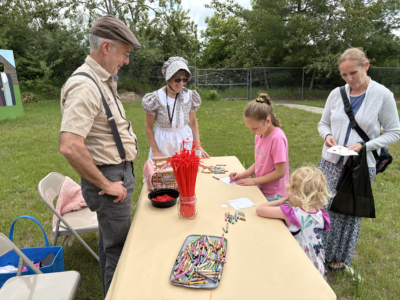Alpena-area sinkhole offers clues to planet’s early history

Courtesy Photo Colorful microbes line the floor of the Middle Island Sinkhole near Alpena in this courtesy photo shared by the Thunder Bay National Marine Sanctuary.
ALPENA — Purple and white microbes jostling for position at the bottom of an Alpena-area sinkhole may solve a longstanding scientific puzzle, researchers announced last month.
Samples of a microbial mat at the bottom of a 75-foot-deep sinkhole off the north shore of Middle Island, near Rockport State Recreation Area in the waters of Thunder Bay National Marine Sanctuary, answers a question scientists have asked for decades about the rise in Earth’s oxygen levels, according to a report recently released by the University of Michigan.
Researchers studied the sinkhole to test a theory linking an increase in Earth’s oxygen early in our planet’s history — when days lasted as few as six hours, scientists think — to longer days as the planet’s rotation speed slowed, according to the U of M report.
Oxygen-poor, sulfur-rich groundwater seeping through Northeast Michigan limestone and settling in the bottom of the sinkhole creates an ecosystem scientists believe closely resembles the shallow seas of early Earth.
At night, at the bottom of the sinkhole, white bacteria climb to the top of the microbial mat to feast on sulfur, the bacteria’s main energy source.

Courtesy Photo Diver Russ Green, scientific diver for the Thunder Bay National Marine Sanctuary, approaches a gas-created mound in the microbial mat on the floor of the Middle Island Sinkhole near Alpena in this courtesy photo shared by the Thunder Bay National Marine Sanctuary.
Each morning, the white microbes creep downward as purple microbes slide to the top, where they capture energy from sunlight and release oxygen.
Longer days mean more oxygen produced, sinkhole studies confirmed, offering a possible explanation of a primeval process that gradually led to a planet ready for plant and animal life, scientists believe.
CAPTURING JELL-O
Capturing a jarful of the bacterial mat and underlying sediment “is like trying to trap wriggly Jell-O,” said Stephanie Gandulla, research coordinator for Thunder Bay National Marine Sanctuary, who helped the research team gather samples for the study.
Off the shore of the mile-long, tree-clad island — which recently went on the market for $3.9 million — the sinkhole looms dark in a satellite image, a stark contrast to the light, Caribbean blue of the shallow water around it.
Gandulla offered a scientist’s-eye view of a sinkhole dive.
Slipping into the water from a research vessel, divers descend following a mooring line securing an overhead buoy, then plunge over an underwater cliff.
Ancient groundwater bursts from between boulders in the sinkhole wall, blurring like a mirage as it blends with the water of Lake Huron in an underwater waterfall.
“It’s kinda trippy,” Gandulla said.
Divers descend “down, down, down” along the nearly vertical wall, she said — down the depth of two telephone poles, past flow meters pushed horizontal by the strength of the flowing groundwater.
With light entering through the one-quarter of the sinkhole not surrounded by a vertical wall, visibility at the sinkhole’s bottom reaches 15 to 50 feet, depending on the season and how carefully divers avoid stirring up sediment, Gandulla said.
A thick layer of sediment, not rock, underlies the bacterial mat at the sinkhole’s base, and “who knows where the bottom really is,” she said.
Divers attempt to keep the bacterial mat intact as they drive acrylic, foot-tall sampling tubes through the sediment and cap the ends.
Sometimes, divers get creative to capture the samples scientists need, using syringes or even zipper-close bags to collect water, sediment, or the purple, brown, and white mat Gandulla described as similar to a layer of whipped cream on a gelatin-dessert parfait.
Check out the video below. Viewing on mobile? Turn your device horizontally for the best viewing experience. Story continues below the video.
THE FUTURE IN OUR BACK YARD
As Middle Island Sinkhole microbes allow researchers to peer into the planet’s past, they may also aid scientists’ ongoing search for extraterrestrial life on habitable planets in and beyond the solar system, according to Bopaiah Biddanda, researcher and professor at Grand Valley State University and one of the report’s authors.
Continuing studies of the sinkhole’s complex microbial ecosystems may lead to answers to science’s enduring questions, from greater understanding of life’s evolution to the discovery of life-saving pharmaceutical compounds, Biddanda said.
“And the best part is, they are right here in our back yard,” the scientist said.
- Courtesy Photo Colorful microbes line the floor of the Middle Island Sinkhole near Alpena in this courtesy photo shared by the Thunder Bay National Marine Sanctuary.
- Courtesy Photo Diver Russ Green, scientific diver for the Thunder Bay National Marine Sanctuary, approaches a gas-created mound in the microbial mat on the floor of the Middle Island Sinkhole near Alpena in this courtesy photo shared by the Thunder Bay National Marine Sanctuary.





